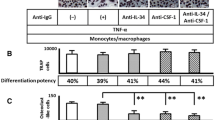Summary
Interleukin-1 (IL-1) mediates its effects through two distinct receptors, one of 80 kilodaltons (80 kD) present in athymic lymphocytes and fibroblasts, and one of 60 kD present in cells of the monocyte-macrophage lineage. A novel monocyte cytokine in the IL-1 family which binds to both the 80 and the 60 kD receptors has been purified, cloned, and expressed. As the interleukin-1 receptor antagonist (IL-1ra) has been shown to inhibit bone resorption in organ culture, it is not clear whether these effects are mediated through the 80 or the 60 kD receptor. Recently, neutralizing antibodies (35F5) have been developed to the 80 kD receptor which inhibit IL-1 effects mediated through this receptor. To determine the importance of the 80 kD receptor to IL-1-mediated bone resorption, we used the neutralizing antibodies (35F5) to the 80 kD receptor to determine if they inhibited bone resorption stimulated by IL-1 in bone organ cultures. The 35F5 antibody blocked bone-resorbing activity due to IL-1 completely, and also blocked control or “endogenous” bone-resorbing activity present in murine bone organ cultures incubated in control media. The 35F5 antibody had no effect on bone resorption mediated by tumor necrosis factor (TNF), or parathyroid hormone (PTH). These data suggest that the availability of the 80 kD IL-1 receptor is required for osteoclastic bone resorption mediated by IL-1.
Similar content being viewed by others
References
Arend WP, Dayer JM (1990) Cytokines and cytokine inhibitors or antagonists in rheumatoid arthritis. Arthritis Rheum 33:305–315
Hannum CH, Wilcox CJ, Arend WP, Joslin FG, Dripps DJ, Heimdal PL, Armes LG, Sommer A, Eisenberg SP, Thompson RC (1990) Interleukin-1 receptor antagonist activity of a human interleukin-1 inhibitor. Nature 343:336–340
Eisenberg SP, Evans RJ, Arend WP, Verderber E, Brewer MT, Hannum CH, Thompson RC (1990) Primary structure and functional expression from complementary DNA of a human interleukin-1 receptor antagonist. Nature 343:341–346
Chizzonite R, Truitt T, Kilian PL, Stern AS, Nunes P, Parker KP, Kaffka KL, Chua AO, Lugg DL, Gubler U (1989) Two high-affinity interleukin-1 receptors represent separate gene products. Proc Natl Acad Sci 86:8029–8033
Carter DB, Deibel MR, Dunn CJ, Tomich CSC, Laborde AL, Slightom JL, Berger AE, Bienkowski MJ, Sun FF, McEwan RN, Harris PKW, Yem AW, Waszak GA, Ghosay JG, Sieu LC, Hardee MM, Zurcher-Neely HA, Reardon IM, Heinrikson RL, Truesdell SE, Shelly JA, Eessalu TE, Taylor BM, Tracey DE (1990) Purification, cloning, expression and biological characterization of an interleukin-1 receptor antagonist protein. Nature 344:633–638
Seckinger P, Klein-Nulend J, Alander C, Thompson RC, Dayer JM, Raisz LG (1990) Natural and recombinant human IL-1 receptor antagonist block the effects of IL-1 on bone resorption and prostaglandin production. J Immunol 145:4181–4184
Gowen M, Nedwin G, Mundy GR (1986) Preferential inhibition of cytokine-stimulated bone resorption by recombinant interferon gamma. J Bone Miner Res 1:469–474 n
McIntyre KW, Stepan GJ, Kolinsky KD, Benjamin WR, Plocinski JM, Kaffka KL, Campen CA, Chizzonite RA, Kilian PL (1991) Inhibition of interleukin 1 (IL 1) binding and bioactivity in vitro and modulation of acute inflammation in vivo by IL-1 receptor antagonist and anti-IL-1 receptor monoclonal antibody. J Exp Med 173:931–939
Sabatini M, Boyce B, Aufdemorte T, Bonewald L, Mundy GR (1988) Infusions of recombinant human interleukin-1 alpha and beta cause hypercalcemia in normal mice. Proc Natl Acad Sci 85:5235–5239
Gowen M, Meikle MC, Reynolds JJ (1983) Stimulation of bone resorption in vitro by a nonprostanoid factor released by human monocytes in culture. Biochem Biophys Acta 762:471–474
Gowen M, Mundy GR (1986) Actions of recombinant interleukin-1, interleukin-2 and interferon gamma on bone resorption in vitro. J Immunol 136:2478–2482
Tashjian AH, Voelkel EF, Lazzaro M, Goad D, Bosma T, Levine L (1987) Tumor necrosis factor α (cachectin) stimulates bone resorption in mouse calvaria via a prostaglandin-mediated mechanism. Endocrinology 120:2029–2036
Garrett IR, Durie BGM, Nedwin GE, Gillespie A, Bringman T, Sabatini M, Bertolini DR, Mundy GR (1987) Production of the bone-resorbing cytokine lymphotoxin by cultured human myeloma cells. N Engl J Med 317:526–532
Boyce BF, Aufdemorte TB, Garrett IR, Yates AJP, Mundy GR (1989) Effects of interleukin-1 on bone turnover in normal mice. Endocrinology 125:1142–1150
Boyce BF, Yates AJP, Mundy GR (1989) Bolus injections of recombinant human interleukin-1 cause transient hypocalcemia in normal mice. Endocrinology 125:2780–2783
Stashenko P, Dewhirst FE, Peros WJ, Kent RL, Ago JM (1987) Synergistic interactions between interleukin-1, tumor necrosis factor, and lymphotoxin in bone resorption. J Immunol 138: 1464–1468
Stashenko P, Dewhirst FE, Rooney ML, Desjardins LA, Heeley JD (1987) Interleukin-1β is a potent inhibitor of bone formation in vitro. J Bone Miner Res 2:559–565
Sabatini M, Garrett IR, Mundy GR (1987) TNF potentiates the effects of interleukin-1 on bone resorption in vitro. J Bone Miner Res 2:34
Roodman GD, Takahashi N, Bird A, Mundy GR (1987) Tumor necrosis factor (TNF) α stimulates formation of osteoclast-like cell (OCL) in long-term human marrow cultures by stimulating production of interleukin-1 (IL-1). Clin Res 35:515A
Pfeilschifter J, Chenu C, Bird A, Mundy GR, Roodman GD (1989) Interleukin-1 and tumor necrosis factor stimulate the formation of human osteoclast-like cells in vitro. J Bone Miner Res 4:113–118
Thomson BM, Saklatvala J, Chambers TJ (1986) Osteoblasts mediate interleukin-1 stimulation of bone resorption by rat osteoclasts. J Exp Med 164:104–112
Author information
Authors and Affiliations
Rights and permissions
About this article
Cite this article
Garrett, I.R., Guise, T.A., Bonewald, L.F. et al. Evidence that interleukin-1 mediates its effects on bone resorption via the 80 kilodalton interleukin-1 receptor. Calcif Tissue Int 52, 438–441 (1993). https://doi.org/10.1007/BF00571333
Received:
Revised:
Issue Date:
DOI: https://doi.org/10.1007/BF00571333




